La Palma #6: Bananas - the crooked gold of the Canaries? [EN/GER]
If you are at La Palma, you cannot escape one thing: Canarian bananas! In every supermarket you will find this yellow, well-known fruit (fresh or dried with salt or cinnamon). And throughout the island, you can see plantations everywhere.
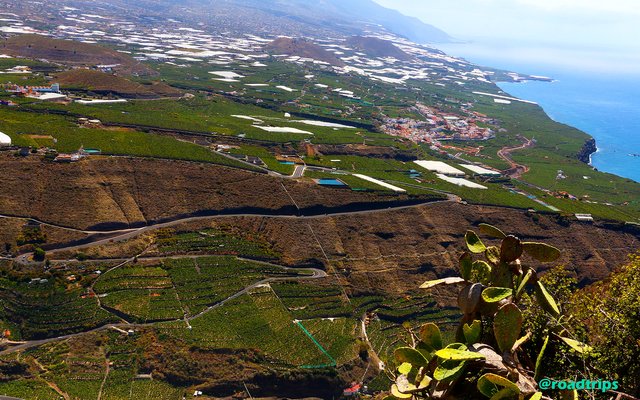 Countless banana plantations - sometimes covered with white plastic film
Countless banana plantations - sometimes covered with white plastic film
It was probably the British who introduced the cultivation of bananas on La Palma in 1896.
Today, these plantations still cover more than 3,000 hectares. The dimensions that are difficult to imagine, but after our roadtrip through the island, it was clear to us that every free area below approx. 400 meters is used for the cultivation of these crooked fruits.
What an incredible monoculture!
We suppose that the production of bananas is the most important source of income for the island besides tourism. On the other hand, we also read that the banana plantations can only be kept alive through subsidies.
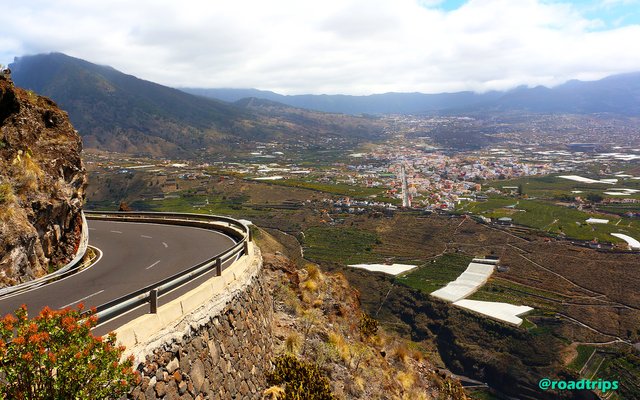
However, these yellow fruits are almost exclusively exported to Spain (mainland). No wonder why we have never seen Canarian bananas in the supermarket in Germany.
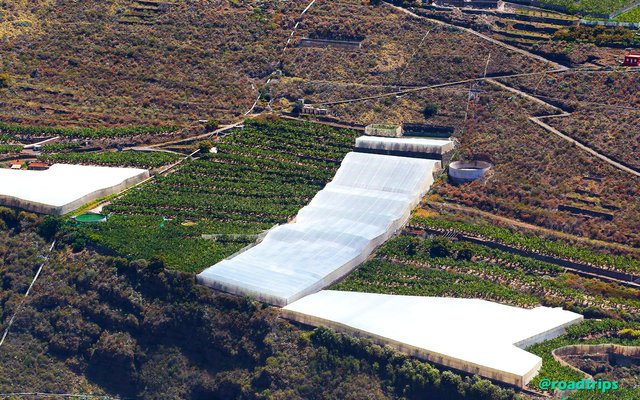 A lot of banana plants are covered with with plastic foil
A lot of banana plants are covered with with plastic foil
Per year, 100,000 tonnes of bananas are harvested on La Palma – incredible number, isn’t it? From flowering to ripe, bananas usually take 6 months, a plant can have up to 300 fruits.
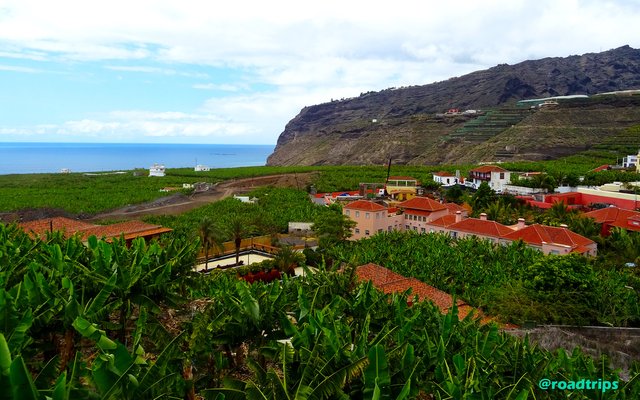
Let’s talk about the ecological aspect now. From cultivation to harvest, you need 1.000 liter of water for 1 kg of bananas. Yes. Right. 1 kg bananas = 1.000 liters of water. What a grotesque number!
And this on an island which is very dry and poor in water anyway. From an environmental point of view, these monocultures are therefore not really appropriate.
However, these plantations secure an incredible number of jobs and belong to the island image like the black sand beaches.
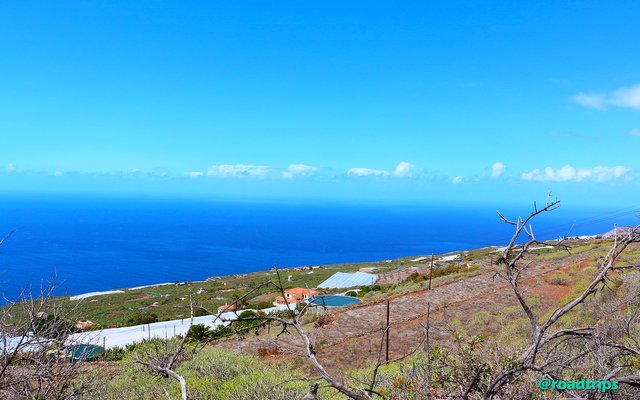 Dryness, bananas and the deep blue sea
Dryness, bananas and the deep blue sea
So, you surely can’t name bananas the crooked gold of La Palma. Although they seem to bring more effort and burden than economic returns, they are still landmarks on the island and make an important contribution to the lives of the locals.
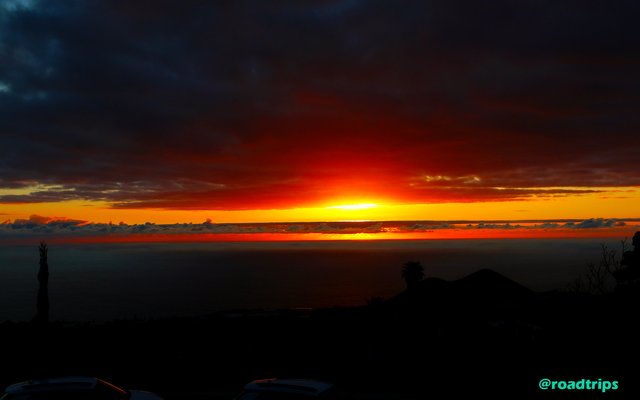 Sunset at the banana-island
Sunset at the banana-island
(Source of the banana-facts: https://www.lapalma.de/bananen)
German (same post)
Bananen – das krumme Gold der Kanaren?
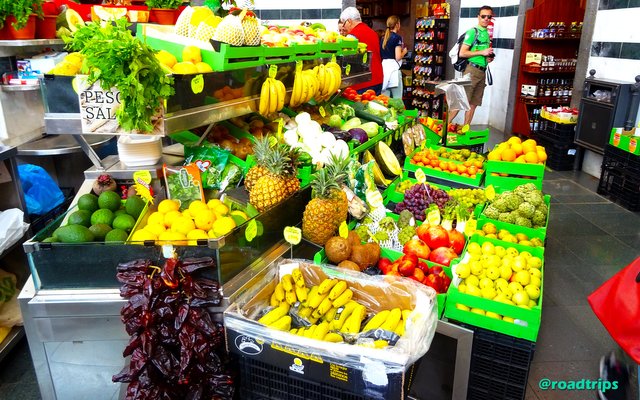
Wenn man auf La Palma ist, kann man einer Sache nicht entkommen: kanarischen Bananen! In jedem Supermarkt findet man dieses Obst tonnenweise (ob frisch oder getrocknet mit Salz oder Zimt). Und auf der gesamten Insel erstrecken sich hektarweise deren Plantagen.
 Unzählige Bananen-Plantagen – teilweise mit weißer Folie abgedeckt
Unzählige Bananen-Plantagen – teilweise mit weißer Folie abgedeckt
Es waren wohl die Briten, die 1896 den Anbau von Bananen auf La Palma einführten.
Heute sollen sich diese Plantagen noch über 3.000 Hektar erstrecken. Das sind schwer vorstellbare Dimensionen, aber spätestens nach unserem Roadtrip war uns klar: jede freie Fläche unterhalb von ca. 400 Metern wird für den Anbau dieser krümmen Früchte genutzt.
Was für eine unglaubliche Monokultur!
Wir vermuten, dass die Produktion der Bananen neben dem Tourismus die wichtigste Einnahmequelle der Insel darstellt. Andererseits haben wir auch gelesen, dass die Bananenplantagen nur durch Subventionen am Leben erhalten werden können.

Exportiert werden die gelbleuchtenden Früchte allerdings fast ausschließlich nach Spanien (Festland). Kein Wunder also, weshalb wir in Deutschland noch nie Kanarische Bananen im Supermarkt gesehen haben.
 Viele Bäume stehen unter Folie
Viele Bäume stehen unter Folie
Pro Jahr werden auf La Palma unglaubliche 100.000 Tonnen Bananen geerntet. Von der Blüte bis zur reifen Banane vergehen in der Regel 6 Monate, wobei eine Staude 300 Früchte umfassen kann.

Nun zum ökologischen Aspekt. Vom Anbau bis zur Ernte benötigt man für 1 Kg Bananen 1.000 Wasser. Ja. Richtig. 1 Kg Bananen -> 1.000 Liter Wasser. Eine groteske Zahl!
Und das auf einer Insel, die ohnehin schon sehr trocken und wasserarm ist. Aus Umweltsicht machen diese Monokulturen folglich alles andere als Sinn. Hinzu kommen eingesetzte Pestizide und Belastung der Böden als negative Argumente.
Allerdings sichern diese Plantagen unglaublich viele Arbeitsplätze und gehören zum Bild Insel wie die schwarzen Sandstrände.
 Trockenheit, Bananen und das tiefblaue Meer
Trockenheit, Bananen und das tiefblaue Meer
Als krummes Gold kann man Bananen folglich sicher nicht bezeichnen. Obwohl sie scheinbar mehr Mühe und Belastung als wirtschaftlichen Ertrag bringen, sind sie dennoch Wahrzeichen der Insel und leistet einen wichtigen Beitrag zum Leben der Einheimischen.
 Sonnenuntergang auf der Bananen-Insel
Sonnenuntergang auf der Bananen-Insel
(Quelle der Bananen-Facts: https://www.lapalma.de/bananen)

Congratulations, Your Post Has Been Added To The Steemit Worldmap!
Author link: http://steemitworldmap.com?author=roadtrips
Post link: http://steemitworldmap.com?post=la-palma-6-bananas-the-crooked-gold-of-the-canaries-en-ger
Want to have your post on the map too?
Hiya, @LivingUKTaiwan here, just swinging by to let you know that this post made into our Top 3 in Daily Travel Digest #558.

Your post has been manually curated by the @steemitworldmap team. If you like what we're doing, please drop by to check out all the rest of today's great posts and consider upvoting and supporting us.
100 Snax tokens will be in your wallet by next Monday courtesy of @crowdmind. Learn More